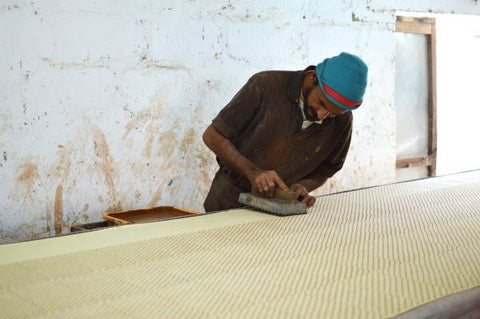Imagine we came to you and said: we'd like 200 of the same painting. It should be hand painted, with the same exact process and order of steps for each of the 200 paintings, the same amount of time spent on each, and we'd like them to be identical. Do you think, looking closely at each individual painting, they would be truly identical? Would it matter? Or, would you say, wow, how cool is this, I have 200 works of art. Someone painted each one, and they look beautiful!
The next time you look at an ajrakh piece, you should have the same thought. Dating back many centuries, Ajrakh block-printing is a traditional Indian craft that uses vivid natural dyes and wooden blocks to print unique patterns on cotton fabric. The process is elaborate and laborious, requiring numerous stages of printing, dyeing, and washing to achieve the gorgeous designs.

Ajrakh is said to come from the Hindi word ‘aaj rakh”, meaning “keep it today” or “making beautiful”. Some also believe the word may have roots in the word, “azrak”, Arabic for “blue”.

Ajrakh was historically characterized by its symmetrical geometric patterns, with some floral designs. As the tradition was passed down through generations, the Ajrakh printing technique developed to include a much wider variety of motifs and patterns.

Every layer of each design requires a different hand-carved wooden block for printing. This can add up to a lot of blocks!

The Ajrakh technique begins by washing the cloth numerous times, called Saaj, and treating the cloth, Kasanu, to make the cotton softer and more absorbent of the dyes. After prepping the fabric, the craftsmen start printing. The multi-day, multi-step process includes many layers of resist printing and dyeing to achieve the final product.

The crafters start out by “resist printing”, which protects the areas where the dye is not going to be printed. Before any colors can be added, the artisans define the outline of the pattern in a step referred to as Rekh.

Then, they can begin block printing with the colored dyes. While the Ajrakh printing process was originally limited to dark red and indigo with elements of black & white, there is a wider spectrum of colors that Ajrakh artisans use today.

If the pattern incorporates blue in its design, the cloth is dyed with indigo in a plastic barrel, clay vessel, or concrete vat.

The dyeing is followed by rinsing and drying the fabric in the sun, a step known as Vicharnu.
Next, the cloth is boiled in a solution during a stage called Rang (meaning “color” in Hindi), that reveals the black and red colors fully to achieve those truly eye-catching designs.

Depending on how deep the colors must be for the desired design of the fabric, Ajrakh printers must repeat the necessary dyeing and washing steps over many days.
Our Fall Blossom print had quite a journey this season! Some uncooperative weather meant insufficient drying periods between steps, which added time to the process. The result is a gorgeous, beautifully printed batch of dresses and skirts, each one a little different than the next. Here's a photo of the varying prints and colors you'll find in our Teddy Dress, Paige Dress and Nahla Skirt. Consider them a piece of art, just like the hypothetical 200 paintings we asked you for, and their differences become their power.
Check out all the new styles in our latest collection!
——————————————————————————————————————-
For a more detailed look at the steps in the process, check out The Hindu’s article on Ajrkah printing.



